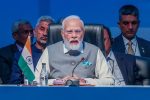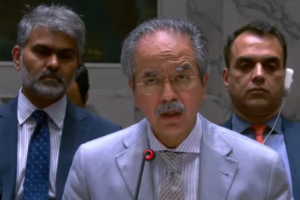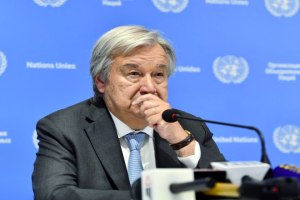In this very writing attempt has been made to understand the relevancy of Gandhi and his thoughts, which refers to Cleanliness, sanitation, or popularly known as ‘Swachhata’ and the SBM. However, in India Gandhian paradigm differ hugely on account of myriad Political-Economic and, Societal norms.. Yes, India achieved freedom under the leadership of Mahatma, but his dream of a clean India is still unfulfilled. Gandhi argued that, “Sanitation and cleanliness” is more significant than independence. So this is our collective responsibility to fulfilled the dream of a clean India. To the students his advice was, “If you become your own scavengers, you will make your surroundings clean. It needs no less courage to become an expert scavenger than to win a Victoria Cross.”
Today, Prime Minister Narendra Modi officially launched the emoji of Mahatma Gandhi on Twitter, Twitter India said in a statement.
In South Africa the whites despised the Indians for their slovenly habits. Gandhi inspected their quarters and asked them to keep their homes and surroundings clean. He spoke about it at public meetings and wrote in newspapers etc. Gandhi’s house in Durban was built in western fashion while he described himself as a bhangi and argued he would be content if he could die as a sweeper. He even asked orthodox Hindus to make him suffer social boycott along with the untouchables. Moreover, Two thousand teachers and students were specially trained for doing the scavenging at the Haripura Congress. Gandhi could not think of having a set of people labelled as untouchables for cleaning filth and dirt. He wanted to abolish untouchability from India. Whenever Gandhi got an opportunity to do a little bit of cleaning work, he felt happy. To him the test of a people’s standard of cleanliness was the condition of their latrines.
Converting a ‘toilet movement’ into a ‘social movement’ wherein actual toilet usage becomes a norm will call for pulling lessons from the life of Gandhi.
Historically, During Gandhi’s second trip to India from South Africa, he attended the Congress Session in Calcutta to plead the cause of the ill-treated Indians in South Africa. Notably, The sanitary condition of the Congress camp was horrible while some delegates used the veranda in front of their room as latrines, others did not object to it. He reacted immediately. When he spoke to the volunteers, they said; “This is not our job, this is a sweeper’s job.” Gandhi asked for a broom and cleaned the filth. He was then dressed in western clothes. The volunteers were astonished but none came forward to assist him. Years later, when Gandhi became the guiding star of the Indian National Congress, volunteers formed a bhangi (sweeper) squad in the Congress camps where for once the Brahmins worked as bhangis.
Cleanliness is most important for physical well-being and a healthy environment. It has bearing on public and personal hygiene. It is essential for everyone to learn about cleanliness, hygiene, sanitation and the various diseases that are caused due to poor hygienic conditions. He made cleanliness and sanitation (sanitation for all) an integral part of the Gandhian way of living. sanitation for all. Significantly, Gandhi’s group launched a mass contact programme in the villages. “At the end of the morning’s march,” writes Tendulkar, “a batch of men and women from his party visited the Harijan quarters of the village, taking with them brooms and spades.” They talked about the necessity of sanitation, about keeping their yards clean, of burying rubbish, instead of leaving it to blow here and there.
In 2018, “Swachh Office” competition was held among all Government buildings across the country maintained by CPWD. Painting competition amongst the children was held on the theme ‘Swachhata hi Seva’ at Sunder Nursery in the presence of the Minister and Secretary, MoHUA. CPWD has prepared a film on above activities carried out during Swachhata Hi Sewa Pakhwada across the country, which will be released by Director General, CPWD, Shri Prabhakar Singh, and screened during a function to be held at Nirman Bhawan on Wednesday, October 03, 2018.
In Recent context, On 2nd October, 2014, the Indian PM, Narendra Modi, launched a nation-wide ‘cleanliness campaign’ on the occasion of Mahatma Gandhi’s birth anniversary. The concept of Swachh Bharat is to provide sanitation facilities to every family, including toilets, solid and liquid waste disposal systems, village cleanliness, and safe and adequate drinking water supply. ‘Swachhata Hi Seva Movement’ (2018), which draws kind attention to making ‘Clean India’ and shared public-private-societal responsibility to served swachhata, society at large.
Notably, Embedded in the doctrine of this top-up initiative to the already ongoing ‘Swachh Bharat Mission’ (SBM) is a clear invocation for the public to shun the entrenched notion that cleanliness is but the task of the ‘others’ who have historically been performing it on behalf of the rest of ‘us’. as a principle has become a mass movement to boost nation wide public-private-society participation), considered as a ‘Strong Pillar’ of the “Swachh Bharat Mission” (SBM), and catalyse the fulfilled Bapu’s dream of a Clean India.. Notably, The PM, Narendra Modi, on September 15, 2018, launched the ‘Swachhata Hi Seva Movement’, and said that, ‘Swachh Bharat is not a movement of any Government or any Prime Minister, but an entire nation’s movement’.
Swachhata Hi Seva movement, Aims at generating greater public participation towards Swachhta throughout the nation. Thus, It is being organized in the run up to the 4th anniversary of the Swachh Bharat Mission (SBM), on October 2nd, 2018, which will also mark the commencement of the 150th year celebrations of Mahatma Gandhi. The Prime Minister urged everyone to be a part of this movement and strengthen the efforts to create a ‘Swachh Bharat’. Swachhata must become our Swabhaav, “Youngsters are ambassadors of social change”. The way they have furthered the message of cleanliness is commendable.
To accelerate the efforts to achieve universal sanitation coverage and to put focus on sanitation, the Prime Minister of India, Shri Narendra Modi, launched the Swachh Bharat Mission on 2nd October, 2014. The Mission Coordinator shall be Secretary, Ministry of Drinking Water and Sanitation (MDWS) with two Sub-Missions – the Swachh Bharat Mission (Gramin) and the Swachh Bharat Mission (Urban). The Mission aims to achieve a Swachh Bharat by 2019, as a fitting tribute to Mahatma Gandhi on his 150th birth anniversary.
We may say that, behavioural change that SBM (Swachh Bharat Mission) is trying to inculcate amongst millions. No wonder, lack of sanitation remains an invisible killer. Manifest in it is the worst form of violence, Gandhi had long perceived. Therefore sanitation was made an uncontested metaphor for non-violence, a co-traveler in the quest for both social and political freedom. Having observed scrupulous rules about cleanliness in the west, Gandhi could not resist applying the same in his life, and in the lives of millions who followed him. Much of his work remains unfinished, though.
The original phrase is “Politics is the art of the possible”, which means, “It’s not about what’s right or what’s best. It’s about what you can actually get done”. It’s associated with Realpolitik, a political philosophy of setting pragmatism over your ideological goals. More recently, as I see nations being ravaged by civil wars, and despotic dictators, and ridiculous levels of mis-governance, I begin to realize the magnitude of Gandhi’s contribution to India, the free country..
On Tuesday, October 02, 2018, “In a world where terrorism, radicalisation (Perticularly Radicalisation of youthh), extremism and mindless hate are dividing nations as well as societies, his clarion calls of peace and ahimsa have the power to unite humanity,” said PM Modi in the blog, which he also tweeted. He quoted Sardar Patel as saying – “India is a land of diversity. If there was one person who brought everyone together, made people rise above differences, to fight colonialism and enhanced India’s stature at the world stage, it was Mahatma Gandhi.”
According to the prime minister, the thoughts of Mahatma Gandhi remained as essential in the 21st century as they were in his time and offered solutions to several problems the world faces. He ended this article with a reference to one of Bapu’s favourite hymns – “vaishnav jan to tene kahiye je, peer parayee jaane re.” It meant, said Prime Minister Modi, a good soul is one who feels the pain of others. For me, Bapu’s favourite hymns, “Nobody can hurt me without my permission”-GandhiJI.
























